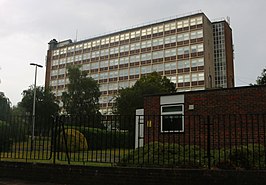
Back هارو (حى هرو لندن) ARZ هرو، لندن AZB Harrow, Llundain Welsh Χάροου (Λονδίνο) Greek هرو، لندن Persian Harrow French Harrow, Londain Irish Harrow Italian ハーロウ (ロンドン) Japanese Harrow KW
| Harrow | |
|---|---|
|
Clockwise from top: St John the Baptist, Greenhill church; Skipping Katie statue; University of Westminster; Hygeia Building and King's House | |
Location within Greater London | |
| Population | 149,246 (2011 Census)[1] |
| Demonym | Harrovian |
| OS grid reference | TQ145885 |
| • Charing Cross | 11 mi (18 km) ESE |
| London borough | |
| Ceremonial county | Greater London |
| Region | |
| Country | England |
| Sovereign state | United Kingdom |
| Post town | HARROW |
| Postcode district | HA1, HA2, HA3 |
| Dialling code | 020 |
| Police | Metropolitan |
| Fire | London |
| Ambulance | London |
| UK Parliament | |
| London Assembly | |
Harrow (/ˈhæroʊ/[2]) is a large town in Greater London, England, and serves as the principal settlement of the London Borough of Harrow. Lying about 9.5 miles (15.3 km) north-west of Charing Cross and 5.4 miles (8.7 km) south of Watford, the entire town including its localities[3] had a population of 149,246 at the 2011 census, whereas the wider borough (which also contains Pinner and Stanmore) had a population of 250,149.
The original settlement was at Harrow on the Hill, atop the 408 feet (124 m) Harrow Hill. The modern town centre of Harrow developed at the foot of the hill, in an area historically called Greenhill, following the opening of Harrow-on-the-Hill station on the Metropolitan Railway in 1880.[4] Harrow became the unofficial "capital" of the Metroland suburbia in the early 20th century.[5] Harrow & Wealdstone station on the West Coast Main Line had opened in 1837, but was more distant from Harrow, lying 1.5 miles (2.4 km) north of the hill.[6] Workers were drawn to the area by the opening of several factories in Wealdstone;[7] Harrow was the base of the large Kodak factory, used for the manufacture of photographic materials and R&D, which was in operation for more than a century.
Historically in the hundred of Gore in the county of Middlesex, Harrow became part of Greater London in 1965. Today, the historic area is distinguished as Harrow on the Hill and is a conservation area with listed buildings of Georgian architecture and home to Harrow School, one of the seven major boys' boarding schools in England as defined by the Public Schools Act 1868. The modern-day town meanwhile is an established commercial centre of outer north-west London and houses a campus of the University of Westminster.
- ^ Harrow consists of 13 wards in the London Borough of Harrow: Greenhill, Harrow on the Hill, Harrow Weald, Headstone North, Headstone South, Kenton East, Kenton West, Marlborough, Rayners Lane, Roxbourne, Roxeth, Wealdstone, and West Harrow. "2011 Ward Census". data.london.gov.uk. Archived from the original on 22 February 2014. Retrieved 9 June 2014.
- ^ Wells, John C. (2008). Longman Pronunciation Dictionary (3rd ed.). Longman. p. 368. ISBN 9781405881180.
- ^ Harrow on the Hill, Harrow Weald, Headstone, North Harrow, Kenton, Rayners Lane, South Harrow, Wealdstone and West Harrow.
- ^ "Heathfield School Harrow". Patfield.com.
- ^ Forrest, Adam (10 September 2015). "Metroland, 100 years on: what's become of England's original vision of suburbia?". The Guardian.
- ^ "10 Oldest Train Stations in the World". Oldest.org. 10 September 2020.
- ^ "BBC - A History of the World - Object : Whitefriars Glass". www.bbc.co.uk.




